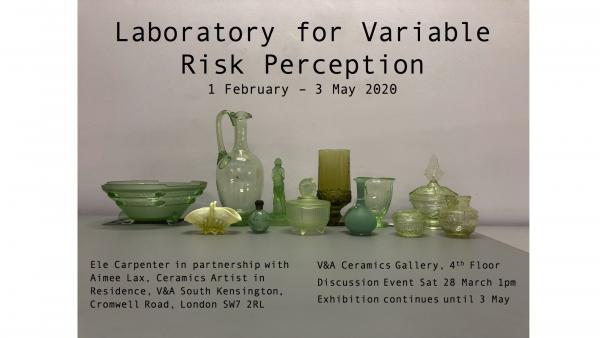
V&A 1 Feb - 4 November 2020
Laboratory for Variable Risk Perception, Ele Carpenter, 2012 - 2020.
Domestic uranium glassware, radon monitor.
In partnership with Aimee Lax, Ceramics Artist in Residence, V&A South Kensington.
The Laboratory for Variable Risk Perception is an installation of domestic uranium glassware by Ele Carpenter exploring the variable risk perception of very low-level radiation. The artwork involves measuring the ionising radioactivity of the glass using different monitors. People have widely ranging perceptions of radioactive risk, from banal denial of the nuclear, to uncanny haunting or psychic fear of radiation. For nuclear advisors uranium glass has been an example of safe radiation levels, whilst others are alarmed by its radioactive content (Skelcher, 2002). Today the glassware is commonly available in charity shops and antique centres. Visitors were invited to use UV torches to see the fluorescence of the glass.
Uranium Glass, sometimes called Vaseline glass, is an alchemical delight radiating an uncanny green glow under ultra-violet light. It provides one of the most familiar everyday experiences of radiation inhabiting our domestic spaces, and can be found throughout the V&A ceramics and glass collections. Uranium Salts (uranium dioxide) have been used to colour glass since the early 19th century, and the earliest glass in this collection dates from about 1870. Since the development of nuclear fission in the 1940s, depleted uranium can also be found as a colourant in glass.
Each time this artwork is on public display the activity of the glass is measured and recorded in a log-book. Using different radiation detectors reveals the complexity of measuring the behaviour of alpha, beta and gamma emissions at different scales. At the V&A a radon monitor is included in the cabinet to detect any radon gas which may be emitted by the glass. Uranium naturally decays into its daughter product Radon, but the gas is usually trapped in the solid glass. At the end of the exhibition the Radon monitor will be sent to Public Health England for analysis. Public Health England provide Radon information and measurement packs for the home and workplace. More info at: www.ukradon.org. After the exhibition closed to the public on 18th March the Radon Monitor continued its work, recording radon levels for three months until the end of April.
V&A Curator Rebecca Luffman has written a blog post about Uranium Glass here:
https://www.vam.ac.uk/blog/museum-life/seeing-more-glow-in-the-dark-glas...
Our Nuclear Heritage starts with uranium, a naturally occurring element as old as the earth, which has fuelled an extraordinary technology whose effects will outlive the human race. Nuclear fission for weapons and energy has produced millions of tons of radioactive waste without a long-term storage solution. In the 21st century nuclear waste agencies are vitrifying high-level waste in glass, and are planning to bury it deep underground in the fossil record in geologic repositories. This process will create a geological strata of radioactive isotopes suspended in glass that will be detectable for millions of years. This artwork combines nineteenth century alchemy with concerns for nuclear safety and the intergenerational responsibility of storing radioactive waste.
The Laboratory for Variable Risk Perception has undergone various iterations exploring the politics and aesthetics of uranium glass. It was first produced under the title ‘Mutually Assured Destruction’ (MAD) as a play on the title of the ‘Making A Difference’ exhibition at Goldsmiths, 2012, where Ele started to record the radiation levels of her growing collection of Uranium glass using a borrowed Geiger counter. The artwork was then renamed 'Singularly Assured Destruction: A laboratory for measuring the variable risk perception of radioactivity' for the exhibition Objects of Transcendence at the Watermans Art Centre, curated by Irini Papadimitriou and Jonathan Munro in 2017. Here the work considered the singular and uncanny risk of nuclear materials at home, rather than the global mutual assured destruction of a nuclear weapons exchange. Finally the artwork was retitled ‘A Laboratory for Variable Risk Perception’ for the Media Archaeology exhibition at the NEON Digital Arts Festival, Dundee, in 2018. This will be the final title of the work for the V&A as it reflects the ongoing process of measuring and recording the radiation levels of the glass, exploring the huge variance in how nuclear risk is perceived.
------
Aimee Lax is V&A Ceramics Artist in Residence. Alongside her studio practice into radioactive mutations, Aimee is hosting a series of interdisciplinary conversations with artists, curators, engineers and scientists about the Anthropocene, climate crisis and alternative energy sources. For this display, Lax has invited Ele Carpenter to present her ‘Laboratory for Variable Risk Perception’ exploring the relationship between art and the nuclear Anthropocene.
www.aimeelax.co.uk/
Ele Carpenter is an artist and curator based in London and Europe. Carpenter is convenor of the Nuclear Culture Research Group at Goldsmiths University of London where she is a Reader in Curating. She is an Associate Curator at Bildmuseet, Sweden, Arts Catalyst UK, and visiting Research Fellow at the Institute of the Arts, University of Cumbria. Ele Carpenter’s curatorial research into nuclear culture includes commissioning new artwork, curating exhibitions, publishing, nuclear site visits and roundtable discussions in partnership with arts organisations and nuclear agencies. She is editor of The Nuclear Culture Source Book, Black Dog Publishing (2016); and curator of Perpetual Uncertainty: Art in the Nuclear Anthropocene, Bildmuseet, Umeå University, Sweden (2017), Z33 House of Contemporary Art, Hasselt, Belgium (2017), and Malmö Konstmuseum, Sweden (2018). http://nuclear.artscatalyst.org